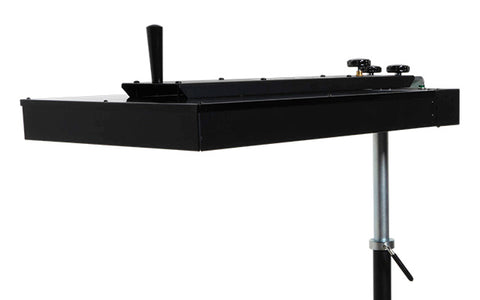A QUICK GUIDE ON SCREEN PRINTING FLASH DRYERS

Screen printing flash units play an important role in the screen printing process, but with so many options available on the market, it can be difficult to determine which one is right for your shop. Let's explore the factors that dictate which flash units suit your needs best.

DEFINING FLASH DRYERS
First, let's discuss what a flash unit does. A flash unit is used to cure or partially cure the ink on a screen before the next layer is printed. It can also be used to evaporate water from cotton shirts or to heat set transfers.
The two main types of flash units are quartz flash units and infrared flash units. Quartz flash units use halogen bulbs to emit high-intensity heat, while infrared flash units use infrared heating elements. Quartz flashes are typically used in shops with automatic presses whereas infrared flash units are most popular with manual print shops.
Besides the two types of flashes, there are several other factors to consider.

ELECTRICAL NEEDS
Flash units vary on the voltage and amp of the plug. Most houses are equipped to handle 120 volts and 15 amps. So, if you're printing out of your house, look for a flash dryer with the specifications.
If you decide to invest in a flash unit with high voltage and amps, have an electrician come to your space and update your new electrical needs.
INSIDER'S TIP: Do not get an adapter for a flash dryer. It may melt the plug and worst case scenario, start a fire. If you get a flash unit that has higher voltage and amps than what your space can handle, hire an electrician to address the situation.

SIZE OF PRINT
Flash dryers vary in size. In the Riley Hopkins line, printers have the option to select either a 16"x16", 18"x18", or 18"x24".
Flashes have a "sweet spot" where the dryer emits the hottest, most consistent heat. As you may have guessed, the sweet spot is typically in the center of the flash unit since less heat is lost to external elements like the wind.
Differently sized flash units have different-sized sweet spots. Riley Hopkins Flash Dryers have an infrared heating element constructed with tight wire construction, reducing the possibility of having hot and cold spots. However, it’s important to get to know your flash unit so you can identify the sweet spot and stay in it when flashing or curing garments.
If you mainly print standard-sized designs like pocket or left chest prints, 8-inch back designs, block letters, etc., a 16x16 or 18x18 will do the trick.
If you print a lot of oversized prints, you'll want a larger flash dryer to ensure it flashes the entire print.
RELATED: TIPS ON USING A FLASH DRYER TO CURE PLASTISOL INK

TYPE OF INK
The type of screen printing ink you're using will have an effect on which flash you should get. If you're mainly printing with plastisol ink, any standard infrared flash dryer works great. Water-based printers should take a look at the forced air flash dryer.
RELATED: FORCED AIR FLASH DRYERS – A TOOL EVERY WATER-BASED PRINTER NEEDS
Lastly, your budget will also dictate which flash unit you should get. Smaller budgets will cover smaller flashes and larger budgets will get you a bigger, more advanced flash dryer.
Ultimately, the type of flash unit that benefits your shop depends on your specific needs and budget. Consider factors like your electricity, the size of screen prints, and the type of ink you use when making your decision.







